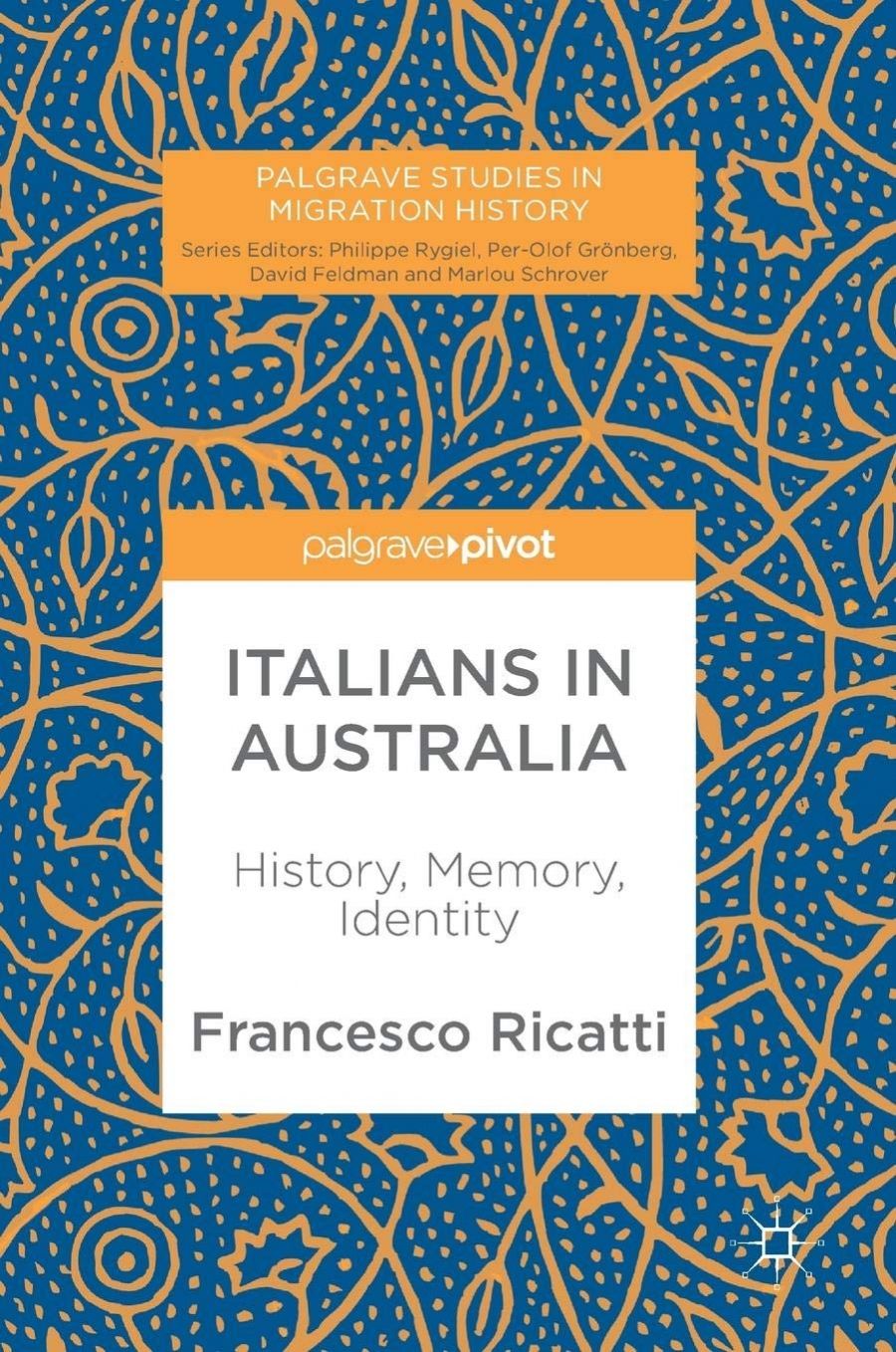
- Free Article: No
- Contents Category: History
- Custom Article Title: Diana Glenn reviews <em>Italians in Australia: History, memory, identity</em> by Francesco Ricatti
- Review Article: Yes
- Custom Highlight Text:
In its interrogation and negotiation of contemporary theoretical frameworks and practices at the core of the Italian–Australian migration complex, Francesco Ricatti’s comprehensive study offers a fresh and lucid understanding of the interrelation of core issues and processes affecting ...
- Grid Image (300px * 250px):

- Book 1 Title: Italians in Australia: History, memory, identity
- Book 1 Biblio: Palgrave Macmillan, $102 hb, 147 pp, 9783319788722
At the heart of this multi-layered process is a transcultural approach that gives recognition to questions of decoloniality and intersectionality. The remaining frames in the author’s hexadic model are the notion of intensity inherent in migrant lives, orientation (‘connection between embodiment and emotional emplacement’), a more critical understanding of belonging conceptualised as the ‘uncanny’ or ‘unhomely’, and situating the role and influence of transcultural memory in the everyday lives of migrants who settled in both urban and isolated areas of the continent and whose unyielding memories shaped future action. In his analysis, the author elicits categorisations and assumptions from existing historiography in order to arrive at a detailed and singular representation of the multiple facets of Australia’s Italian migration story and the contribution that first-generation settlers, in particular, have made to the nation. The necessity and timeliness of the undertaking are outlined by Ricatti: ‘There is now, perhaps, enough historical distance to start re-evaluating Italian migrants’ working lives and socio-economic conditions without having to rely on the rhetoric of sacrifice, hard work, and contribution to the hosting society.’ As such, Ricatti’s focus extends to considerations of phenomena and processes involving transcultural realities and the experience and impact of transnational reallocation and settlement in the host country that, for Italian migrants in the postwar years, necessitated measuring themselves and their cultural concerns against the stringent determinants of assimilationist policies.
Balanced and judicious in its delineation of the major factors contributing to the integration of Italian arrivals over many decades, the volume covers core issues of mobility, religious belief, parochialism, racism, ethnic identity, class exploitation, sexuality, ageing, linguistic markers, political ideology, and events, for instance, the role of the Italian fasci all’estero (overseas Fascist organisations), Italian language media, cultural maintenance, intergenerational tensions, the agency of women, transculturation, and the renegotiation of boundaries. Each chapter presents an abstract and keywords as front-line features to introduce the discussion, with the initial chapter mapping out the theoretical framework and its examination of the importance of a ‘transcultural, decolonial and intersectional approach’. A useful compendium of critical references provided at the conclusion of the chapters assists in tracking pertinent secondary sources for the thematic elements under discussion.
An outline of the historical mass-migration story of Italians in Australia proceeds chronologically in chapter two, and it is well-supported by selected demographic data interspersed with germane insights on women’s migration histories that span questions of cultural maintenance, employment, gender equality, and the phenomenon of proxy brides. The analysis then turns to considerations of work and socio-economic mobility in chapter three, following by a strongly argued chapter on issues of racism and racial ambiguity in a settler–colonial context. Where the historical record reveals intake from both northern and southern Italy, the author underscores the estrangement of regional groups as a result of whiteness policy, the discriminatory practices of racially-based selection, and incontrovertible evidence of marginality and cultural dislocation. Ricatti tackles head-on the challenges of whiteness and racial ambiguity and situates whiteness at the core of the nation’s identity, class structure, and democratic principles, thereby pinpointing the legitimising of select regional group identities to the detriment and exclusion of others. Insights on family and generational negotiations are explored in chapter five, with Ricatti affirming that family values are employed by migrants ‘as tools to perform, negotiate, and justify certain practices, according to their individual, family, and community needs’. Lastly, an examination of transnational ideologies and transcultural practices in chapter six casts light on issues related to language, religion, politics, and ethnic media. In his concluding remarks, the author presents a synthesis of other topics and thematic concerns beyond the scope of the volume but deserving of further reflection. It affirms the need for a ‘transcultural history of resilience, resourcefulness, and creativity’.
In sum, Ricatti offers challenging new perspectives that greatly enrich and deepen our awareness and understanding of transnational and transcultural practices in synthesising Italian–Australian migration history over a 150-year trajectory. In his compelling overview, Ricatti obliges us to reconsider and re-evaluate crucial questions of belonging and regional identity transferred to an alien context, and how migrants reposition themselves and their families in the new environment, thus enabling readers to reimagine and reconceptualise memory, identity, and place-making as seminal points of intersection and engagement.


Comments powered by CComment